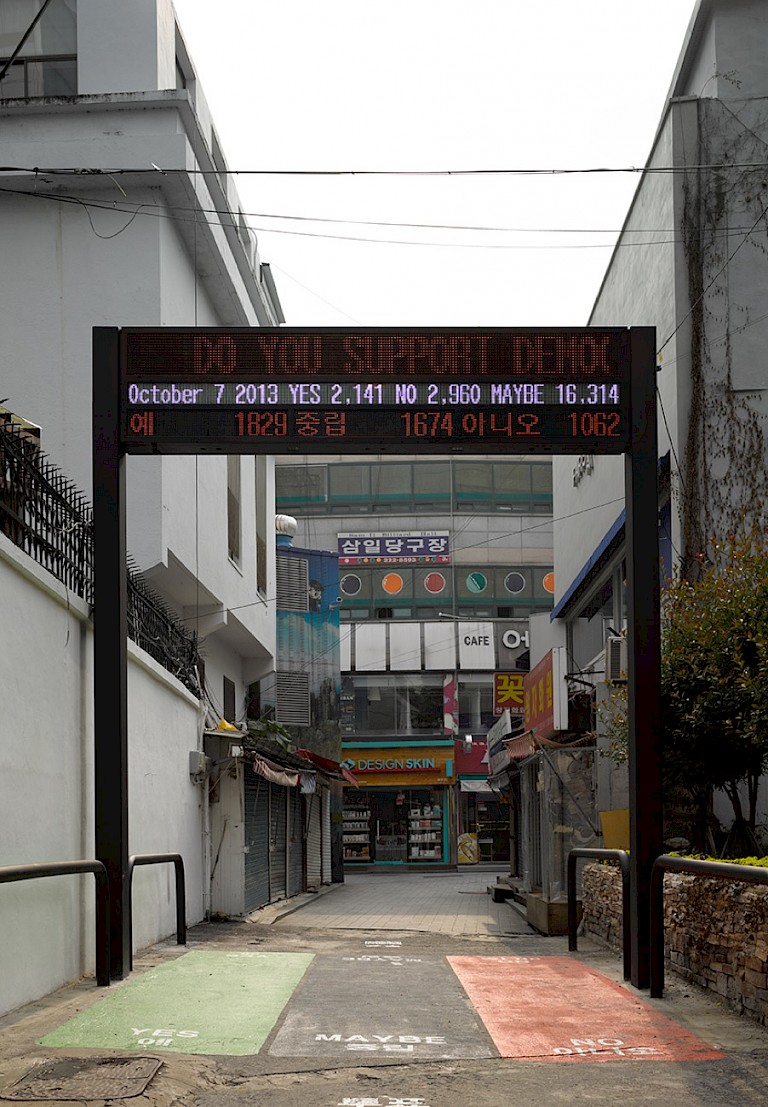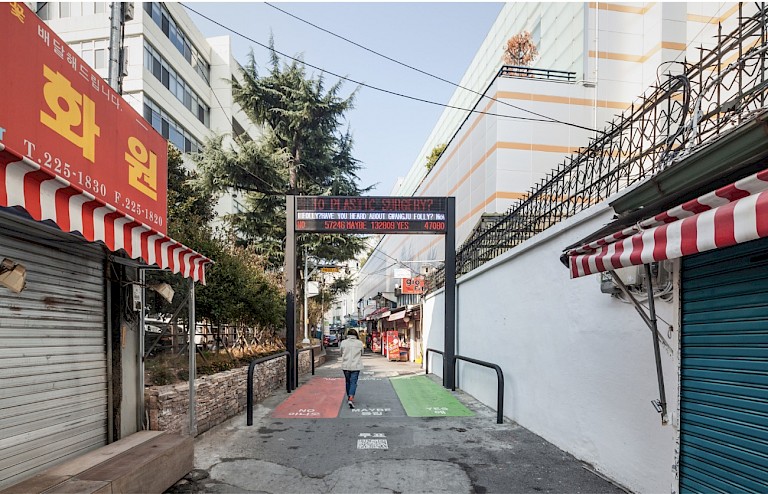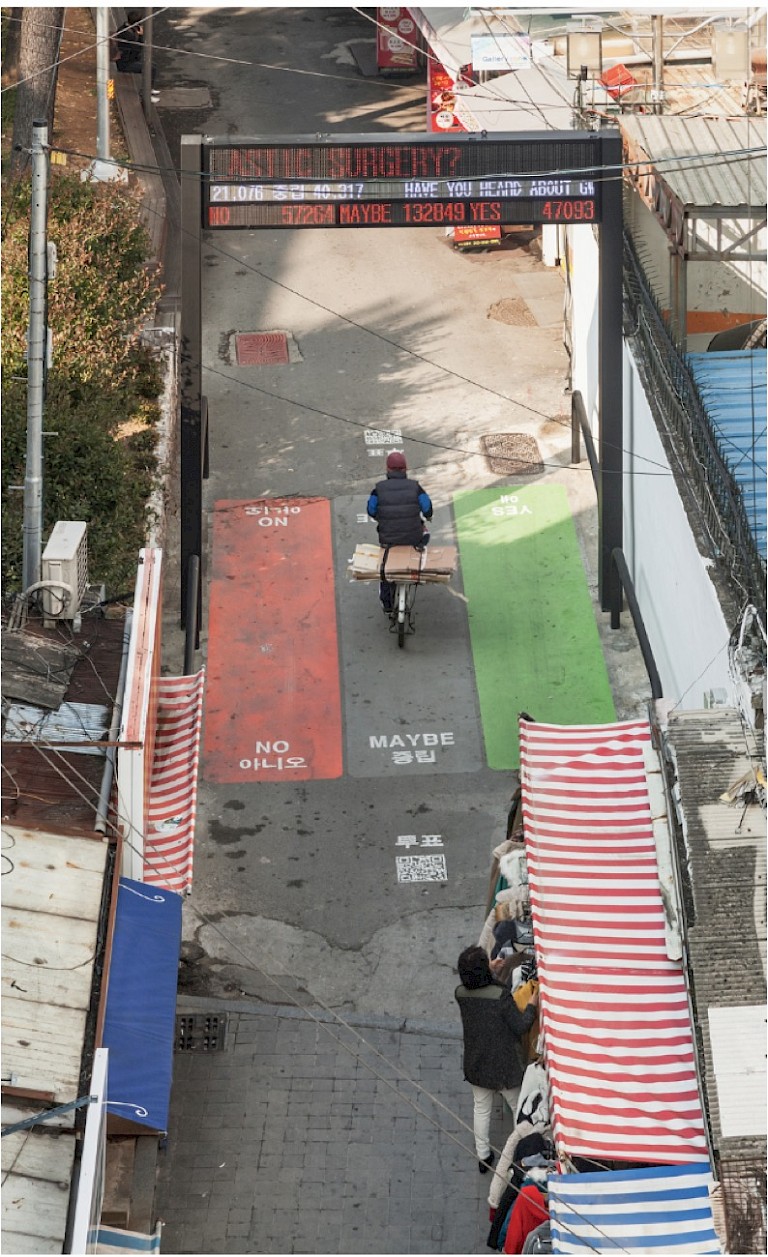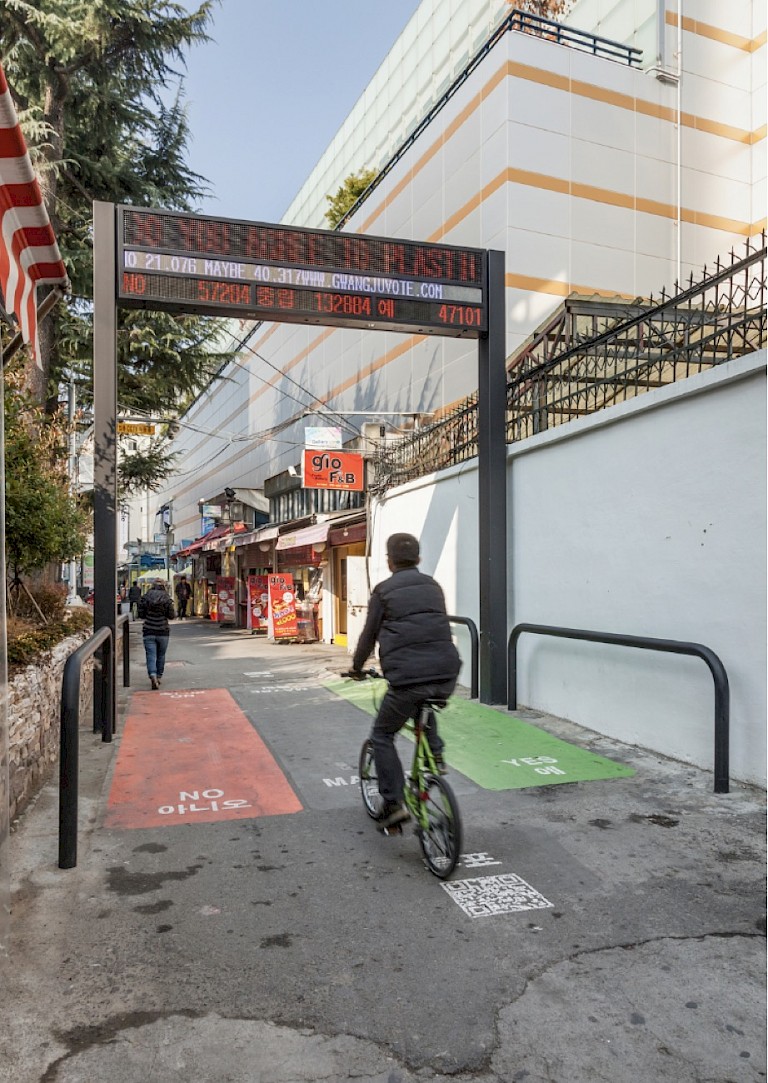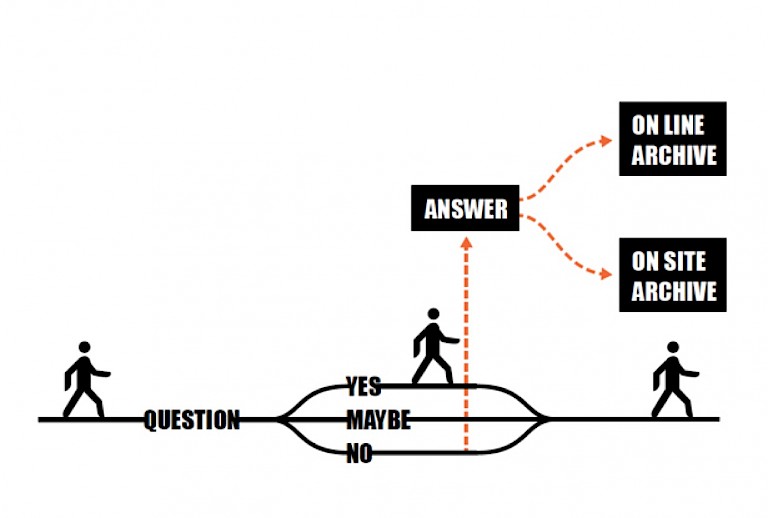



"The Gwangju Folly organizing committee recommends and appoints a number of commissioned creators at each session. Architect Rem Koolhaas and writer Ingo Niermann were one of the commissioned groups of the 2013 project. The two came up with a plan after studying the background and context of Gwangju and the Gwangju Follly. Based on the communication between artists and the executing committee, the location for the work was finally set given the environment of the urban space and historical context. The construction and maintenance costs of The Vote are provided by the Gwangju Folly.
The Vote is an interactive installation. The objects of voting are questions that scroll on the LED screen at the lintel. The questions displayed change every two weeks. These questions come from some non-governmental organizations, and suggestions from online participants are also heavily considered -- the questions raised by the netizens that receive the most support are expected to be selected as official questions for voting and set up in The Vote.
Nevertheless, from the perspective of work maintenance, the continuous investment in collecting and presenting discussion topics, and archiving statistical results is a huge job. Unlike the construction of other physical spaces, without the production of content and continuous discussion generating around it, the vitality of this work will radically decline. According to the initial design of the work, audiences can follow the statistics of voting results and raise new questions for voting through the website (www.gwangjuvote.com). By the time of composing this research (October, 2023), this time-based website is no longer accessible. And previous voting record is archived at the Gwangju Folly website (https://www.gwangjufolly.org/bbs/board.php?bo_table=en_folly2_vote_list&page=10) with 147 questions. "
"The Vote is more of an interactive installation than an architectural design. Unlike most projects in ""Folly"" that create or transform existing urban spaces, this work forms a cultural and ideological environment parallel to the physical space by setting a rule of interaction. Delving deeply into the logic and meaning behind the creation of the work, we can see its redefinition of ""audience"" and ""public participation methods"". More importantly, this work showcases a possibility of involving audiences and presenting their individual ideas on social issues through the media of art and the form of public participation, which is pioneering. It also inspires us to contemplate on the impact of public participation on community and public cultural space making.
The work is shaped like a door frame and spans the entire street. Whether pedestrians or non-motor vehicles, it is inevitable to pass through one of the lanes marked with color. And each ""passing"" will be recorded by the sensor above the head and become part of the cumulative count. Therefore, whether intentionally or unintentionally, everyone becomes a participant in the voting. This seemingly passive form of participation creates equality and democracy among participants. While politically relevant voting still involves qualification checks (e.g., qualifications as “citizen”, or “resident” of the place), the artwork Vote truly addresses all those who live in the city and cross the street as voters, regardless of nationality or background, making “participation” a natural attribute and automatic involvement for everyone.
Besides, this work set the rule of public participation in an extremely simple and accessible way, that is, “passing the road”. This makes “voting with feet” possible. Many public installations appear to be interactive and are designed to enhance the audience's sense of participation; but the way of interaction requires sometimes instruction, or even didactic guidance -- “participation” itself turns out to be a high-threshold action. On the nearly “extreme” contrary, this work counts ""walking"" and ""passing"" as direct ways of participation.
This work was placed on a busy street, seemingly to increase its exposure to the public and enhance the possibility of audience participation. But it brought about an unexpected effect: many passersby slow down, think or hesitate for seconds, and then selectively pass the gateway marked with different colors. This action of ""slowing down"" signifies the conscious participation of the audience. And it proves that this art work makes people (start to) think. As the way of voting becomes rather simple and even rash, people even turn to be more cautious.
Undoubtedly, The Vote is not intended to act as or replace existing polling mechanisms, and the data recorded in this work may be hardly used for serious research reports (since its statistical methods do not meet scientific rigor). On the other hand, the questions raised for voting touches nothing on political or controversial sensitivity on national politics or world structure, but are mostly social issues pertinent to everyone's lives, which provides agency for most people to make their individual comments. Some of the questions that were voted on during the project include: Do you support plastic surgery? Do you think the lowest wage is enough? Do you think the city needs to be rebuilt? Do you think the number of doctors in Korea is insufficient?
In the name of art, architecture and urban renewal, this work became a highlighted spot in the neighborhood, and the topics involved naturally developed into the contents for discussion among the people in the community and beyond. It then also generates a kind of ""word of mouth"" spread according to its innate characteristics. There are indeed many residents from other regions who come all the way to ""pass by"" here, expressing their opinions on the question for voting, and contributing to the data for countering. According to website archive, among the 147 voting records by March 2021, the number of participants, that is, pedestrians passing by that location, varies from nearly 50,000 to nearly 300,000. Coupled with different times of the year, this has inadvertently become a tool for passenger flow statistics.
Whether it is active participation for expressing one’s opinions, or passive participation when encountering, or even rushing by unconsciously, this simple device creates an atmosphere of participation and discussion for the community, encouraging people living in the city to be engaged in public discourses with the free will to express.
The impact of the work Vote on the community or the public does not lie in the direct, result-oriented, and obvious spatial transformation, but in the subtle influence on the community's public awareness of discussion and the formation of a democratic and free atmosphere. Audiences who participate in or learn about this work online can sense, and thus think about the impact and significance of individual actions on the collective, i.e., community, society, and even the country. From the perspective of artistic practice, the work explores the possible ways in which public discussions and opinion expressions are transformed through art. It is novel and offers also the potentiality for further expanding interdisciplinary exchange with sociology, psychology, etc."
The Artists
Rem Koolhaas (Rotterdam, 1944) founded OMA in 1975 together with Elia and Zoe Zenghelis and Madelon Vriesendorp. He graduated from the Architectural Association in London and in 1978 published Delirious New York: A Retroactive Manifesto for Manhattan. In 1995, his book S,M,L,XL summarized the work of OMA in "a novel about architecture". He co-heads the work of both OMA and AMO, the research branch of OMA, operating in areas beyond the realm of architecture. His built work includes the Axel Springer Campus in Berlin (2020), the Qatar National Library and the Qatar Foundation Headquarters (2018), Fondation Galeries Lafayette in Paris (2018), Fondazione Prada in Milan (2015/2018), Garage Museum of Contemporary Art in Moscow (2015), the headquarters for China Central Television (CCTV) in Beijing (2012), Casa da Musica in Porto (2005), Seattle Central Library (2004), and the Netherlands Embassy in Berlin (2003). Current projects include the Taipei Performing Arts Centre. Koolhaas directed the 2014 Venice Architecture Biennale, is a professor at Harvard University, and curated Countryside: The Future (2020), an exhibition about the non-urban areas around the globe that opened in February 2020 at the Guggenheim Museum in New York.
